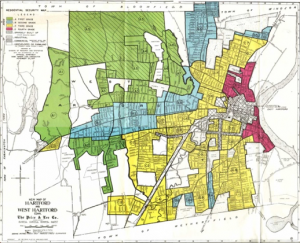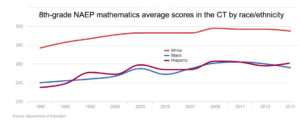How Public Schools Work:
The school system is divided into districts that determine where children attend school. However, due to practices like redlining, schools mere towns apart can be funded drastically differently. Redlining segregates between low-income and high-income neighborhoods, creating stark contrasts between schools. Connecticut as a whole has been historically impacted by redlining. Many areas in Hartford like the South West and Behind the Rocks Neighborhoods contain public schools that are under-resourced and understaffed. Schools in such areas tend to have low test scores and high dropout rates compared to nearby upper-middle-class neighborhoods.

(Above is a chart showing the historic impact of redlining on the Hartford area)
Magnet Schools:
The most significant investment into the Hartford school system over the past 50 years has been the creation of magnet schools. The magnet school system was created in Hartford in response to the famous Sheff v. O’Neill civil rights case, which proved that low-income students in Hartford were not receiving the equal education they deserved. Magnet schools have many attractive features to entice upper-class white parents to combat segregation. Some of the many assets of magnet schools are well-trained teachers, specially themed programs, art classes, and most importantly, free tuition. However, students have to enter a lottery to get into a magnet school. Although magnet schools are a step in the right direction towards school equality, the children that can’t afford private school and aren’t chosen by the lottery will have to attend their local public school. Between the Southwest and Behind the Rocks Neighborhoods there are currently 11 magnet schools. However, the average rating among them on a popular school ranking website for parents is a B- (NICHE 2021). Such a score implies that even the options curated to give low income children a better education are falling short.
What are the measures of a “good” school?
- Test scores
- Graduation rate
- Per-pupil funding

(Figure 1)
Figure 1 displays the per-student funding across Connecticut in 2021. As you can see, there is a nearly three thousand dollar discrepancy between per-pupil funding in areas that are predominantly white VS schools that are predominantly BIPOC. According to our demographics section, Behind the Rocks and South West tend to fall under the “majority BIPOC” or “diverse population” categories meaning that students in their schools are receiving drastically less funding per student compared to neighboring white towns.

(Figure 2)
Figure 2 shows how test scores of middle schoolers in Connecticut have changed over the past 25 years based on race. Even over time, white students have dramatically higher test scores compared to black or Hispanic students. Considering the disadvantages for BIPOC students built into the school system, many struggle to succeed in our local public schools due to understaffed schools, lack of specialized education, and underfunding.